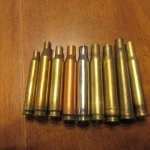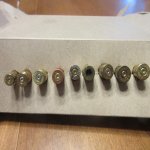So, this is getting totally interesting! First of all, to Tiriaq and Cosmic, I give full credit to you both for the extent of your knowledge of things, including the obscure details of the history of various vintages of 303 British brass. However, I still disagree with Cosmic on some pretty important stuff.
Specifically, I have no idea why you are so concerned about something so relatively-unimportant as the consistency of the size of the flash holes of PPU brass, but never took the time to determine if the stuff lasted longer than common North American junk brass. Weren’t you curious about that – especially since you did take note of how the PPU brass was/ is is substantially heavier that the junk commercial stuff? Why wasn’t/ why isn’t that THE priority?
Why do you seem to treat the presence or absence of a web inside the case as a non-issue, saying “Still stuck on the web thing... Given that the incipient separation occurs ahead of the web, one could easily argue that provision of a web solves one problem and creates another.” Why did you care a rat*’s a*s whether the Herter’s stuff – that you gave-up – had an unimportant relief cut ahead of the rim yet, again, you didn’t test the stuff for longevity?
To me, longevity is number one. Nothing else matters if the brass you are using dies, when it isn’t supposed to! This is bad Karma, as far as I’m, concerned. I like the L-E because it is a tough, battle-proven gun and is really “all business”. Contrast that with running the gun with prissy brass that is basically made to fail. That contrast is bizarre to me.
As for why the junk 303 British brass – that you seem to be Okay with – fails at a place forward of the expansion ring, I can say this is sometimes, but not aways true. I have certainly seen case separation at the expansion ring area itself , but agree that the failure often is forward of this point.
As for why that happens that way, I think I know. Ever done any winching, or towing? What happens when a chain under tension breaks? Not much – the ends just fall to the ground. What happens when a cable breaks? A lot of really bad stuff. The new ends – of the broken cable – spring back violently. If one of these catches you, you can be severely injured.
Why? Because, if you put a stress gauge on the cable on either side of the pending point where the cable was about to break, you’d find that the gauge would measure a large amount of tension and when the cable breaks, the areas on either side of the break abruptly suffer a complete reversal of forces – from tension to compression.
Exactly the same thing happens when the inside of a 303 British case fails, in a way that releases tension on the case – when the interior wound opens-up behind the expansion ring. This shocks the metal on either side of the expansion ring, but the shock has the greatest effect ahead of the expansion ring, because the metal in that area (say, half an inch forward of the expansion ring, towards the neck) is much thinner than the part behind the expansion ring, towards the base of the case.
This means that those expansion rings aren’t something that you don’t need to be concerned about – as Cosmic suggests. The really abrupt change of tension – as the expansion ring wound occurs – effectively shocks the brass, ahead of the expansion ring and triggers the head separation. Cause and effect, baby!
Specifically, I have no idea why you are so concerned about something so relatively-unimportant as the consistency of the size of the flash holes of PPU brass, but never took the time to determine if the stuff lasted longer than common North American junk brass. Weren’t you curious about that – especially since you did take note of how the PPU brass was/ is is substantially heavier that the junk commercial stuff? Why wasn’t/ why isn’t that THE priority?
Why do you seem to treat the presence or absence of a web inside the case as a non-issue, saying “Still stuck on the web thing... Given that the incipient separation occurs ahead of the web, one could easily argue that provision of a web solves one problem and creates another.” Why did you care a rat*’s a*s whether the Herter’s stuff – that you gave-up – had an unimportant relief cut ahead of the rim yet, again, you didn’t test the stuff for longevity?
To me, longevity is number one. Nothing else matters if the brass you are using dies, when it isn’t supposed to! This is bad Karma, as far as I’m, concerned. I like the L-E because it is a tough, battle-proven gun and is really “all business”. Contrast that with running the gun with prissy brass that is basically made to fail. That contrast is bizarre to me.
As for why the junk 303 British brass – that you seem to be Okay with – fails at a place forward of the expansion ring, I can say this is sometimes, but not aways true. I have certainly seen case separation at the expansion ring area itself , but agree that the failure often is forward of this point.
As for why that happens that way, I think I know. Ever done any winching, or towing? What happens when a chain under tension breaks? Not much – the ends just fall to the ground. What happens when a cable breaks? A lot of really bad stuff. The new ends – of the broken cable – spring back violently. If one of these catches you, you can be severely injured.
Why? Because, if you put a stress gauge on the cable on either side of the pending point where the cable was about to break, you’d find that the gauge would measure a large amount of tension and when the cable breaks, the areas on either side of the break abruptly suffer a complete reversal of forces – from tension to compression.
Exactly the same thing happens when the inside of a 303 British case fails, in a way that releases tension on the case – when the interior wound opens-up behind the expansion ring. This shocks the metal on either side of the expansion ring, but the shock has the greatest effect ahead of the expansion ring, because the metal in that area (say, half an inch forward of the expansion ring, towards the neck) is much thinner than the part behind the expansion ring, towards the base of the case.
This means that those expansion rings aren’t something that you don’t need to be concerned about – as Cosmic suggests. The really abrupt change of tension – as the expansion ring wound occurs – effectively shocks the brass, ahead of the expansion ring and triggers the head separation. Cause and effect, baby!
Well - Your old Herters brass came from Higginsons years ago, and is of Scandinavian origin (Metallverken?). I had some, didnt particularly like it as 50% of the cases did not have a relief cut ahead of the rim, and fed poorly in my P-14s. Cant comment on the longevity, as I gave it away.
The PPU comes from the former Yugoslavia. It became more available after the wall fell, and moreso available these days. The ammo is budget grade, nothing more.
I've had various calibers over the years, including 303. It is thicker than most 303 brass, but that may be its only attribute. Poorly drilled flash holes (undersize), case runout, and varying neck ID/wall thickness are common faults that I have encountered. I have not tested it for longevity, as I have a large stash of Dominion and Imperial brass that I prefer to use.
Let us know how your PPU adventure goes. If you have an opportunity, pick up some of the older Remington brass, you may be pleasantly surprised.
BTW - What kind of groups are you getting with the pulled Russian pills? Are they copper clad steel jacket?
Last edited:















































































